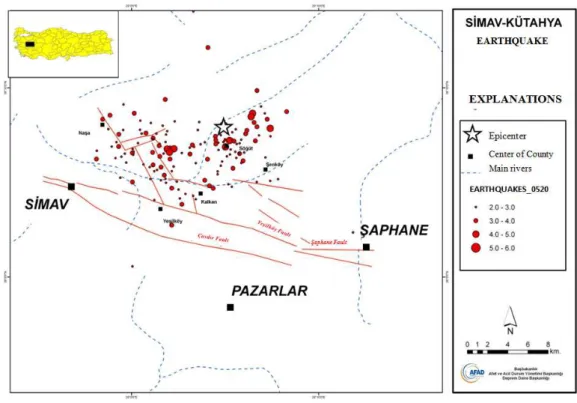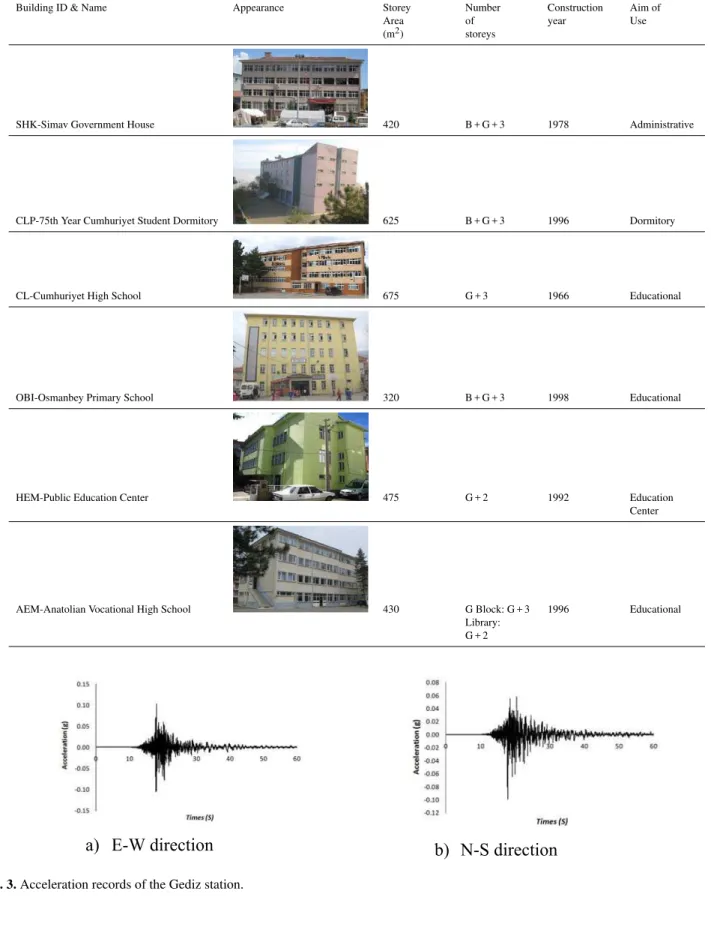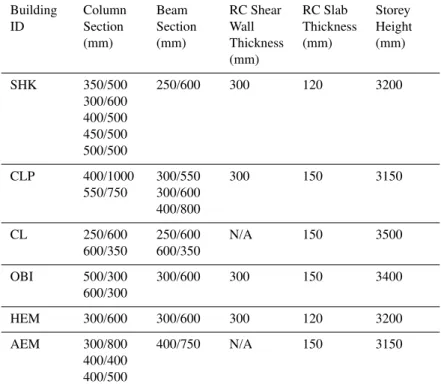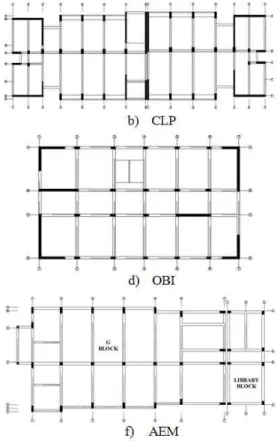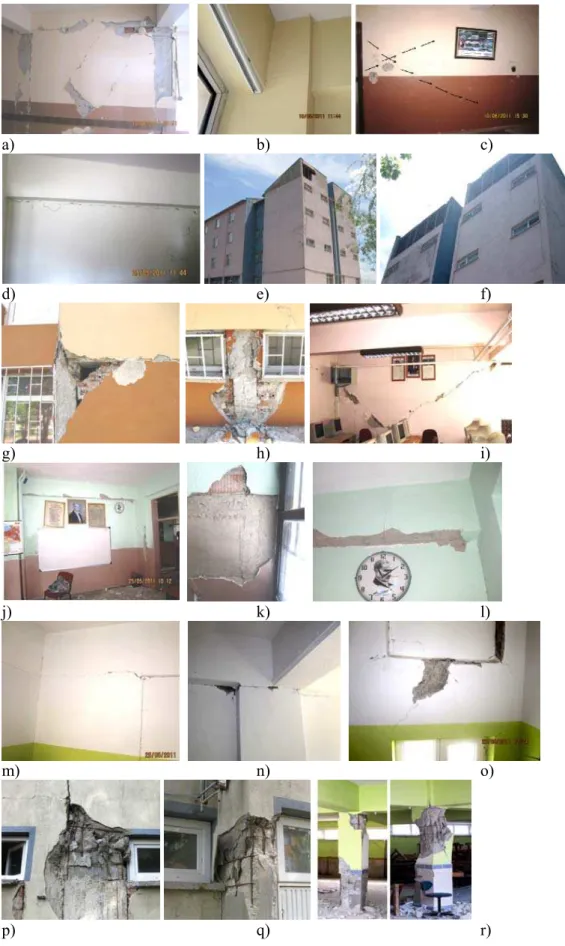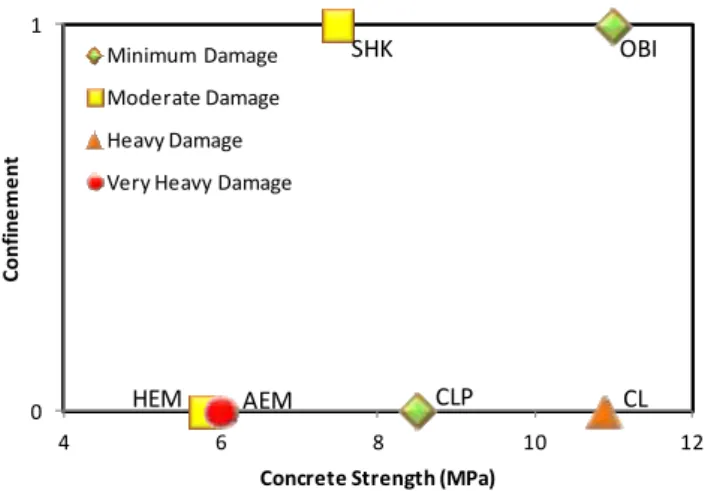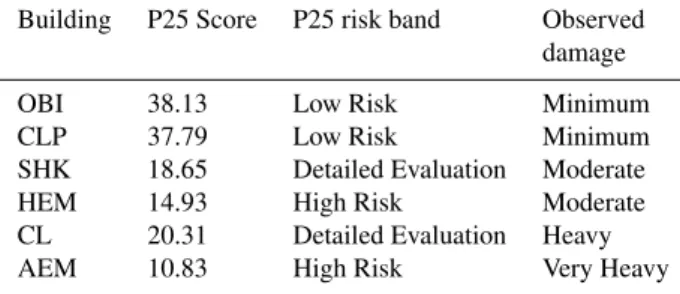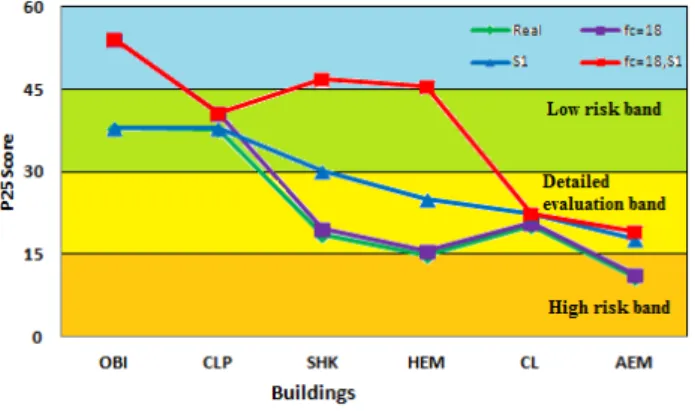www.nat-hazards-earth-syst-sci.net/12/2709/2012/ doi:10.5194/nhess-12-2709-2012
© Author(s) 2012. CC Attribution 3.0 License.
and Earth
System Sciences
Structural damages observed in state buildings after Simav/Turkey
earthquake occurred on 19 May 2011
Y. S. Tama
Department of Civil Engineering, Pamukkale University, Denizli, Turkey Correspondence to:Y. S. Tama (ystama@pau.edu.tr)
Received: 29 March 2012 – Revised: 23 June 2012 – Accepted: 17 July 2012 – Published: 27 August 2012
Abstract. Different levels of damages occurred in state buildings, especially in educational facilities, during the Simav earthquake (ML=5.7) on 19 May 2011. A site sur-vey was carried out in the area after the earthquake, where six state buildings were examined in detail. The results of the survey showed that main reasons for the formation of damages in these buildings are the use of low strength con-crete, insufficient reinforcement, inappropriate detailing, and low-quality workmanship. The investigated buildings were also evaluated by P25-rapid assessment method. The method demonstrates that two of the buildings in question are in “high risk band”; the other two fall into “detailed evaluation band”, and the rest are in the “low risk band”. This figure also matches with the damages observed in the site survey.
1 Introduction
In the last two decades, devastating earthquakes occurred in Turkey causing extensive damages in state buildings, while most of these engineered buildings have regular structural systems. As a result of these earthquakes, many hospitals, schools and dormitory buildings collapsed resulting in sig-nificant numbers of causalities. Meanwhile, as the damaged buildings went out of service or completely collapsed, it was not possible to use them in relief efforts after such disas-ters (Sezer et al., 2003; Gur et al., 2004; Kaplan et al., 2004). Simav is located in the Aks¸ehir–Simav fault sys-tem (ASFS), which is a big seismogenic zone. ASFS is a normal oblique fault system with high seismicity. In this region, intensive seismic activity was observed in the last few years (see Fig. 1). In fact, major earthquakes occurred in this region in the past. These are 1928 Emet (M=6.2), 1944 S¸aphane (M=6.2), 1970 Gediz (M=7.2) and 1970
C¸ avdarhisar (M=5.9) earthquakes, which occurred in the instrumental period, and resulted in significant damages (Ka-plan et al., 2011).
A moderate-sized earthquake occurred in Simav county of K¨utahya Province, Turkey, on 19 May 2011. The earthquake caused severe structural damages mainly in the city center of Simav. Within the scope of the official post-earthquake damage assessments, 31 127 independent structural units (i.e. houses, offices, depots etc.) were examined. It was identi-fied that only 13 169 of them were undamaged. Out of the damaged structures, 199 of them collapsed, 2867 of them heavily damaged, 1761 of them were moderately damaged, and 13 131 of them were slightly damaged by the earth-quake (K¨oksal et al., 2011).
This study focuses on damages that occurred in the state buildings caused by Simav earthquake. For this purpose, structural properties of these buildings were investigated. Through examination of the damages, it was aimed to iden-tify what kind of structural problems resulted in their occur-rence. Meanwhile, these buildings were also evaluated by ing P25-rapid assessment tool, which was developed by us-ing Turkish Damaged Buildus-ing Inventory.
2 Seismological issues
On 19 May 2011, at 23:15 LT, a moderate-sized earthquake occurred in Simav county of Turkey. According to Disaster and Emergency Management Presidency of Turkey (DEMP), the epicentral coordinates of the earthquake are 39.1328◦
N– 29.0820◦
E. The magnitude and depth of the earthquake, re-ported by DEMP, areML=5.7 and 24.46 km, respectively.
2
Fig. 1.Tectonics of the region and distribution of earthquake epicenters (AFAD, 2011).
a) E-W direction b) N-S direction
Fig. 2.Relationship between epicentral distance and maximum acceleration.
earthquake, and as 92.33 cm sn−2(gal) towards N-S direction by the same station. Reliable measurement data were not ob-tained by Simav station due to its failure. Maximum acceler-ation values measured by different stacceler-ations and the distances of these stations to the epicenter of the earthquake are given in Fig. 2. The maximum acceleration values at the city center of Simav were predicted as 214 cm sn−2 (gal) towards N-S direction and 247 cm sn−2(gal) towards E-W direction (Inel et al., 2011). Acceleration values recorded at Gediz station are given in Fig. 3. Very low ground acceleration values are clearly observed for Gediz City, where no damage was re-ported.
3 Properties of investigated buildings
Table 1.Basic data of investigated buildings.
Building ID & Name Appearance Storey Area (m2)
Number of storeys
Construction year
Aim of Use
SHK-Simav Government House 420 B + G + 3 1978 Administrative
CLP-75th Year Cumhuriyet Student Dormitory
CLP-75th Year
625 B + G + 3 1996 Dormitory
CL-Cumhuriyet High School
et
675 G + 3 1966 Educational
OBI-Osmanbey Primary School
y School
320 B + G + 3 1998 Educational
HEM-Public Education Center 475 G + 2 1992 Education Center
AEM-Anatolian Vocational High School
AEM-Anatolian Vocational High
430 G Block: G + 3 Library: G + 2
1996 Educational
a)
E-W direction
b)
N-S direction
Table 2.Section properties of ground floor of investigated buildings.
Building ID
Column Section (mm)
Beam Section (mm)
RC Shear Wall Thickness (mm)
RC Slab Thickness (mm)
Storey Height (mm)
SHK 350/500 300/600 400/500 450/500 500/500
250/600 300 120 3200
CLP 400/1000 550/750
300/550 300/600 400/800
300 150 3150
CL 250/600
600/350
250/600 600/350
N/A 150 3500
OBI 500/300 600/300
300/600 300 150 3400
HEM 300/600 300/600 300 120 3200
AEM 300/800 400/400 400/500
400/750 N/A 150 3150
Table 3.Material properties and detailing.
Building ID
Concrete Strength (MPa)
Steel Type
Corrosion Hook Angle (Degree)
Stirrup Confinement Zone Length (mm)
SHK 7.5 S220 Not
observed
90◦ φ8/200/120 700
CLP 8.5 (B&G) 14.5 (1st) 7.6 (2nd) 5.0 (3rd)
φ8/200/200 N/A
CL 10.9 φ6/200/200 N/A
OBI 11.0 (B) 9.0 (Others)
φ8/200/120 500
HEM 5.8 (G)
11.1 (Others)
φ8/250/250 N/A
AEM 6.0 φ8/200/200 N/A
stock of the state structures in Turkey. Similarly, the proper-ties of the buildings, such as short column, end wall, the year of construction, the strength of concrete and the details of confinement, show variation in the selection. The dimensions of the structural elements in the ground floors are given in Table 2. Meanwhile, the structural plans of the buildings are shown in Fig. 4. As seen from the figure, in some of the build-ings, the structural elements of the same dimensions are used
2
Fig. 4.Structural plan of the buildings.
type of reinforcement (i.e. S220 steel) had been used. Mean-while, visual inspection of the damaged items demonstrates that confinement is poor at the end of the frame elements.
4 Observed damages
State buildings such as Government House, Governor’s Of-fice, schools and hospitals are the structures that should be used immediately after an earthquake for the purpose of ad-ministration and/or for relief efforts. Thus, these buildings should be constructed properly such that they are not dam-aged by an earthquake and they keep on providing service.
During the Simav earthquake, which occurred on 19 May 2011 with a magnitude ofML=5.7, severe damages that occurred in structural systems of many state buildings and as a result of this they became out of service. Within the scope of this study, the damages occurred in six state build-ings were identified, which can be outlined as follows:
– In the Simav Government House (SHK), load bearing elements and infill walls were damaged (Fig. 5a). As seen from Fig. 5b and c, damages in load bearing sys-tems are sliding shear damages on the upper edges of the column and shear cracks at shear walls.
– On the ground floor of the 75th Year Cumhuriyet Dor-mitory (CLP), there are minor infill wall damages and separation between frame and infill walls (see Fig. 5d). Moreover, the end wall on the roof of the structure col-lapsed in the out-of-plane direction because of the earth-quake (Fig. 5e, f). The reasons for this damage were identified as the excessive unsupported wall length and lack of horizontal and vertical bond beams at the end walls.
– In the B block of the Cumhuriyet High School (CL), shear damages occurred on the columns neighbouring the band-type windows due to short column mecha-nisms (Fig. 5g, h). Meanwhile, extensive infill wall damages occurred throughout the structure (Fig. 5i).
– In Osmanbey Primary School (OBI), walls crushed, plaster fell and infill wall-frame separations oc-curred (Fig. 5j). In some beams, cracks formed due to lap splice (Fig. 5k) and flexural forces were identi-fied (Fig. 5l).
a) b)
c)
d) e)
f)
g) h)
i)
j) k)
l)
m) n)
o)
p) q)
r)
Meanwhile, there are shear damages at the short beams connecting to the shear walls (Fig. 5o).
– In Anadolu Vocational High School (AEM), signifi-cant damages occurred on the infill walls and other structural members during the earthquake the occurred on 17 February 2009 with magnitude of ML=5.0 and thereby the building had been evacuated. As there were no partition walls on the ground floor, which was used as a cafeteria, “weak storey” formed and damages concentrated on this floor. In this two-block building, blocks collided with each other during the 2009 Earth-quake as there was no sufficient joint length between them. As a result of this, significant damages occurred on the columns of the pounding parts of the build-ing. In fact, these pounding damages proceeded and the concrete crushed during the recent earthquake that oc-curred on 19 May 2011 (see Fig. 5p). Meanwhile, due to band-type windows, the ground floor of the structure suffers from short column damages. Apart from these, during the earthquake with magnitude of ML=5.0, shear damages occurred on the short columns. In the re-cent earthquake, more severe damages occurred in the building such that crushing of covering concrete and buckling of the longitudinal reinforcements were ob-served (Fig. 5q). Meanwhile, it was detected that, in the 2009 earthquake, bending and shear damages oc-curred on the columns present in the central part of the ground floor. In this recent earthquake with magnitude ofML=5.7, these damages proceeded further ( shown in Fig. 5r).
For the buildings surveyed, the observed level of damages, concrete strength and the confinement of the ground floor in each building are given in Fig. 6. For a structure, it is expected that the increase in the confinement and concrete strength decreases the level of damage. However, the investi-gated buildings point out that such a direct relation between the level of damage and confinement, as well as the concrete strength, is not reliable. For example, it was detected that, in Cumhuriyet High School (CL), while the concrete strength is higher compared to the other structures in question, the dam-age is more severe. The main reasons for these problems are the presence of short columns and soft storey in this building. In contrast to Cumhuriyet High School (CL) in Public Edu-cation Center building (HEM), there is a moderate level of damage while it has the lowest concrete strength compared to the other buildings. This higher performance of the building could be attributed to presence of a regular frame structural system with no weak/soft storey. Meanwhile, higher concrete strength of the upper storeys compared to the ground storey also contributed to this result. Due to short columns and soft storey effect, Anadolu Vocational High School building (AEM), having similar concrete strength to Public Education Center (HEM), was heavily damaged during the earthquake with magnitude ofML=5.7.
0 1
4 6 8 10 12
C o n fi n emen t
Concrete Strength (MPa)
Minimum Damage
Moderate Damage
Heavy Damage
Very Heavy Damage
OBI SHK CL CLP AEM HEM
2
Fig. 6.Effect of concrete strength and confinement on damage level.
5 The performance assessment of the buildings with P25 rapid assessment method
5.1 P25 Method
In order to assess the seismic safety of existing buildings, they should be analyzed using either linear or nonlinear methods according to the relevant codes. However, this pro-cess is neither economical nor practical. Besides, it could be very difficult or even impossible for a huge building stock to perform such an analysis. For this reason, many rapid assessment methods that can determine the seismic risk of structures without detailed analytical studies were developed (Shiga et al., 1968; Bresler, 1977; FEMA 155, 1988; Ohkubo, 1990; NRCC, 1993; Gulkan and Sozen, 1999; Lang, 2002; Yakut, 2004; Xavier et al., 2006; Gulay et al., 2008). In order to develop such a rapid assessment method, a building stock with a specific character is mainly used and the developed method reflects the characteristics of this spec-ified stock. Thus, when a building stock is analyzed by a rapid assessment method, it is important to use a method previously developed for a stock with similar properties. For this reason, in order to analyze the performance of the state buildings in question, P25-rating method (Gulay et al., 2008), which was recently developed for Turkish Building Stock, was used in this study.
Table 4.Calculation of P-scores.
P-score Explanation Formulation
P0 Structural System Score P0=(CA+CI)h0 P1 Basic Structural Score P1=P0·
14 π
i=1fi
P2 Short Column Score Taken from related tables in Gulay et al. (2008).
P3 Soft & Weak Storey Score P3=100·
ra·rr·
hi+1h
i
30.60
P4 Overhangs and Frame Irregularities Score
Taken from related Tables in Gulay et al. (2008).
P5 Pounding Score
P6 Liquefaction Potential Score
P7 Soil Settlement & Displacement Score
Pw Weighted Average Score Pw= P
(wi·Pi) P
wi
wi values are given in Table 5.
P Final Score P =α·β·Pmin
α=
1
I
·(1.4−A0)· h
1
(0.4·n+0.88)
i ·t
βshould be taken from Fig. 7.
Pminis the minimum ofP1−P7.
2
β
Fig. 7.βcoefficient (Gulay et al., 2008).
weighted average and final scores were also calculated for each building in which these seven scores were used.
According to the calculated P scores, buildings are divided into three risk groups. According to this, the buildings with P value less than or equal to 15 are in the “high risk band”, the buildings with P values in the range of 15 and 30 (i.e. 15
<P≤30) are in the “detailed evaluation band” and the build-ings with P values higher than 30 are considered in the “low risk band”.
5.2 Results of rapid assessment
Rapid assessment results for the buildings investigated in this study are given in Table 6. As seen from the table, AEM and HEM buildings are in the “high risk band”, SHK and CL buildings in the “detailed evaluation band” and CLP and OBI
Table 5.wi values forPi scores (Gulay et al., 2008).
Weighting ratio P1 P2 P3 P4 P5 P6 P7 Pmin
wi 4 1 3 2 1 3 2 4
Table 6.P25 Scores and observed damages for buildings.
Building P25 Score P25 risk band Observed damage
OBI 38.13 Low Risk Minimum
CLP 37.79 Low Risk Minimum
SHK 18.65 Detailed Evaluation Moderate
HEM 14.93 High Risk Moderate
CL 20.31 Detailed Evaluation Heavy AEM 10.83 High Risk Very Heavy
2
Fig. 8.Exchange of P25 values.
other parameters were kept constant at their values. In the last step, by using the selected concrete strength and soil type, P25 scores were re-calculated. The variations of the calcu-lated P25 scores are given in Fig. 8.
As a result of the re-evaluation of the buildings in case of 18 MPa concrete compressive strength, only the status of the HEM building changed from “high risk band” to “detailed evaluation band”. For other buildings, there is no change in their status. In the case of S1 soil class assumption, the status of the AEM and HEM buildings changed from “high risk band” to “detailed evaluation band” and that of SHK building changed from ”detailed evaluation band” to “low risk band”. As the OBI building is in S2 and CLP is in S1 local ground class, the status of these buildings did not change.
Evaluation based on 18 MPa concrete compressive strength and the local soil class assumption of S1, SHK and HEM buildings changed from “detailed evaluation band” to “low risk band”. Similarly, AEM building changed from “high risk band” to “detailed evaluation band”. The status of the CL building, for which short column had a significant impact on the performance of the structure, did not change.
6 Conclusions and discussion
On 19 May 2011, an earthquake with moderate magnitude,
ML=5.7, occurred in Simav. In this study, a post-earthquake survey was conducted and six state buildings, representing the state building stock in Turkey, were examined according to the level of damages. By the investigation of these struc-tures, the following conclusions can be drawn.
– In all of the buildings surveyed, there is no sufficient confinement at the ends of the columns, and buckling deformation occurred along the lengths of the columns, which are under effect of axial and flexural loads.
– It was detected that concrete compressive strength of the investigated buildings varies between 5.0 and 14.5 MPa.
– There are shear damages on columns neighbouring the band-type windows because of the short column mech-anisms.
– There are only infill wall damages in the buildings hav-ing well-positioned shear walls. In the others, it was detected that brittle structural damages occurred exten-sively.
– The collapses that occurred at the end walls show that such walls must be secured against out-of-plane motion.
– It was detected that some damages occurred by pound-ing of the adjacent buildpound-ings, as a sufficient gap was not left between them. In such buildings, sufficient gaps should certainly be left between the buildings.
Investigated buildings were also evaluated with the P25 rapid assessment method, which is the most recent method devel-oped for Turkish Building Stock. The results of the evalua-tion are as follows:
– HEM and AEM buildings are in “high risk” band, CL and SHK buildings in “detailed evaluation” band, CLP and OBI buildings in the “low risk” band. The observed levels of damage that occurred in these buildings were found to be correlated with the results of P25 rapid as-sessment.
– The method also gives reasonable results for the as-sumption of the constant concrete strength, which al-lows less material characterization workload. However, assuming a standard soil type without detailed site in-vestigations brings a significant amount of deviation to the results. It can be stated that P25-method can be used for rapid evaluation of the existing buildings.
Acknowledgements. Author acknowledges Hasan Kaplan, Salih
Yilmaz, Hayri Un, Erdal Akyol and Ahmet Sarisin for their valuable comments and help during site investigations.
Edited by: O. Katz
Reviewed by: two anonymous referees
References
AFAD-Republic of Turkey Prime Ministry Disaster and Emergency Management Presidency, http://www.deprem.gov.tr, 2011. Bresler, B.: Evaluation of Earthquake Safety of Existing
Build-ings, Developing Methodologies for Evaluating the Earthquake Safety of Existing Buildings, Earthquake Engineering and Re-search Center Univ. of California, UCB/EERC-77/06, Berkeley, 157 pp., 1977.
Gulay, F. G., Bal, ´Y. E., and Tezcan, S. S.: Calibration of the P25 Scoring Method developed for the seismic safety of rein-forced concrete buildings and its application on a pilot region. T ¨UBITAK (Turkish Scientific and Technical Research Council) Research Project No 106M278, Final Report, 2008 (in Turkish). Gulkan, P. and Sozen, M. A.: Procedure for Determining Seismic Vulnerability of Building Structures, ACI Structural Journal, 96, 3, 336–342, 1999.
Gur, T., Ramizez, J. A., and Sozen, M.: Performance of school buildings in Bingol during the 1st May 2003 earthquake, 8, 2. Earthquake Hazard Center, 1–20, 2004.
Inel, M., Ozmen, H. B., Akyol, E., and Caycı, B. T.: 19 May 2011 K¨utahya- Simav earthquake and aftershocks review report, TM-MOB Denizli Branch of Chamber of Civil Engineers, 1–37, May, 2011.
Kaplan, H., Yilmaz, S., Binici, H., Yazar, E., and Cetinkaya, N.: May 1, 2003 Turkey-Bingol earthquake: damage in reinforced concrete structures, Eng. Fail. Anal., 11, 279–291, 2004. Kaplan, H., Bilgin, H., Yilmaz, S., Binici, H., and ¨Oztas, A.:
Struc-tural damages of L’Aquila (Italy) earthquake, Nat. Hazards Earth Syst. Sci., 10, 499–507, doi:10.5194/nhess-10-499-2010, 2010. Kaplan, H., Tama, Y. S., Yilmaz, S., Kayhan, A. H., and Un, H.:
Pre-liminary Investigation Report of Structural Damages of 19 May 2011 Simav Earthquake, Pamukkale University, 25 May 2011. K¨oksal, T. S., Avs¸ar, O., and Yilmaz, N.: Reasons of structural
dam-ages occurred during 19 May 2011 K¨utahya-Simav earthquake, 1st Turkey Earthquake Engineering and Seismology Conference, METU, 11–14 October 2011.
Lang, K.: Seismic vulnerability of existing buildings, (PhD disserta-tion), Eidgenoessische Technische Hochschule Zuerich, Switzer-land, 2002.
NRCC: Manual for Screening of Buildings for Seismic Investiga-tion, National Research Council of Canada, Ottawa, 1993. Ohkubo, M.: The Method for Evaluating Seismic Performance
of Existing Reinforced Concrete Buildings, Seminar in Struc-tural Engineering, Dept. of AMES, University of California, San Diego, 1990.
Sezer, H., Whittaker, A. S., Elwood, K. J., and Mosalam, K. M.: Per-formance of reinforced concrete buildings during the August 17, 1999 Kocaeli, Turkey earthquake, and seismic design and con-struction practise in Turkey, Eng. Struct. J., 25, 103–114, 2003. Shiga, T., Shibata, A., and Takahashi, T.: Earthquake Damage and
Wall Index of Reinforced Concrete Buildings, Proceedings, To-huku District Symposium, Architectural Institute of Japan, 12, 29–32, 1968.
TEC-Turkish Eartquake Code: Regulations on buildings to be con-structed in seismic zones, Ankara: Ministry of Public Works and Settlement, 2007.
Xavier, R., Guedes, J., Costa, A., and Delgado, R.: Seismic Risk Assessment of Reinforced Concrete Structures, First Eu-ropean Conference on Earthquake Engineering and Seismology, 13ECEES, Geneva-Switzerland, 882, 3–8 September 2006. Yakut, A.: Preliminary Seismic Performance Assessment Procedure
